#Abell 1689
Text

Early Galaxies
121 notes
·
View notes
Text
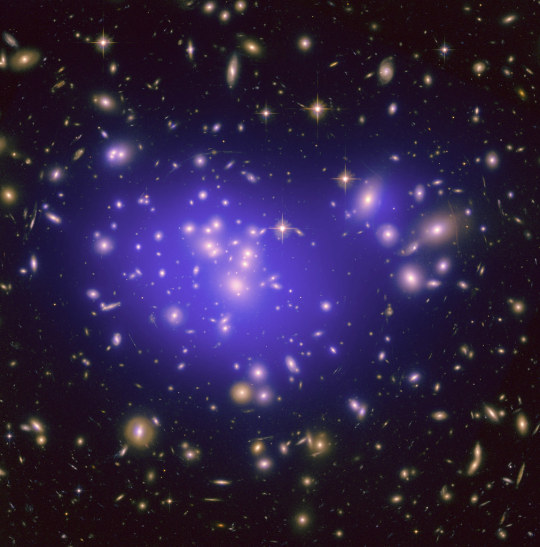
Galaxy Cluster Abell 1689 by NASA Goddard Photo and Video
620 notes
·
View notes
Text
HEY! It’s me, Lump!
Thought I’d make one of these pined post things to introduce myself.
My name is [REDACTED], but you can call me Lump.
I’m a 23 year old ginger, use any pronouns with a slight lean towards they/it, and am an aroace pansexual.
I have a degree in Physics with plans to go into a PhD program for research Astronomy. My area of focus is galaxy structure, formation, and evolution. I’m currently working on my first research papers, adapting my undergraduate thesis work into proper astronomy journal form. I love doing physics and take requests for calculations, stupid or serious (check “#lump’s calculations” for those I’ve done so far, these are my best posts by far).
I try to keep fully nsfw stuff off this blog, but mild nsfw is to be expected
Outside of research, work, and classes I can usually be found gaming, playing MTG, or putting way too much effort into my shitposts while watching something on my second monitor.
If you take one thing away from reading this it’s GO PLAY OUTER WILDS RIGHT NOW. Do not look up anything about it, just play the game and then get your friends to play it. Then we can all talk about it. Please, I need to talk about this masterpiece with more people.
Now that you’ve learned about me I have gained access to your walls. Don’t worry, all I do is nibble a bit of drywall from time to time.
Fun Facts below
My personal motto is: “We do not matter in the grand scheme of the universe, so why not have fun with life.”
My plushies names:
-Tofrug: Lord Squishers
-Manatee: Weapon of Lettuce Destruction
-Reimu Fumo: Air Fried Bastard
-Hydreigon: Hans
-Vaporeon: Dihydrogen Monoxide Puppy
-Meowscarada: Greenfield
-Reshiram: Nuclear Mommy
-Gardevior: Horizon
- Blåhaj: Jimbei
I love nature, and evergreen forests in particular. I enjoy hiking and mushroom and berry picking. My most proud find is this massive cluster of morels I came across a couple years back.


Here’s an overabundance of my personal top 3′s, not necessarily the three I think are best (except Outer Wilds, that’s best thing humanity has produced).
Games: Outer Wilds, FFXIV, Ori and the Will of the Wisps
Manga: One Piece, Jojo’s Bizarre Adventure, Berserk
Books: Red Rising, Percy Jackson, A Song of Ice and Fire
Movies: Monty Python and the Holy Grail, The Secret of Kells, How to Train Your Dragon
Shows: Mob Psycho 100, Good Omens, Ya Boy Kongming!
Characters: Mr Torgue Highfive Flexington, Kronk, Nico Robin
Mountains: Mt. Hood, Sierra de la Laguna, Mauna Kea
Flying Critters: Giant Golden-Crowned Flying Fox, Pelican, Toucan
Landbound Creatures: Red Panda, Jumping Spider, Goliath Frog
Marine Animals: Sea Lion, Lumpfish, Giant Pacific Octopus
Pokemon: Gardevoir, Hisuian Goodra, Zekrom
Soundtracks: FFXIV, Made in Abyss, Wildfrost
Albums: Starship Velociraptor, The Cures What Ails Ya, Westwinds (The Real McKenzies)
Foods: Cottage Pie, Khao Soi, my dad’s Chile Verde
Fruit: Mexican Pitaya, Atemoya, Mango, Huckleberry
Galaxy Clusters: Abell 0209, Abell 1689, macs0416
Here’s a couple of neat galaxy pictures I took using my university’s telescope:


Completely unedited pic of me
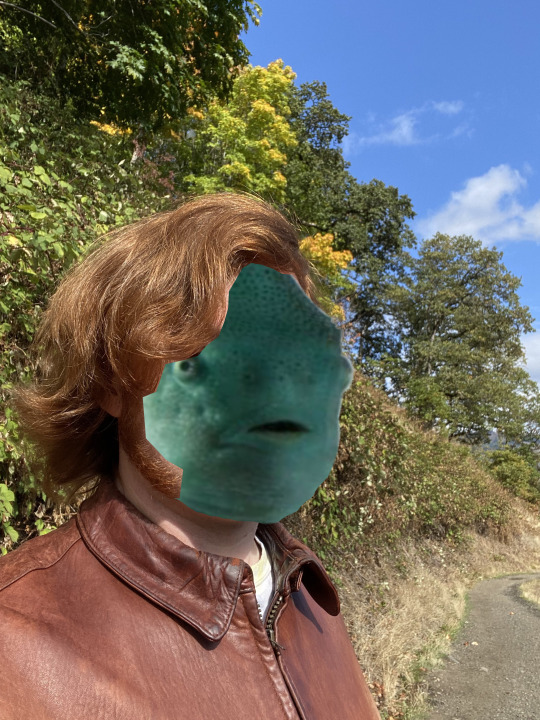
66 notes
·
View notes
Text
Gravitational lensing has to be one of the most visually striking phenomena in astronomy
Gravitational lensing is a phenomenon where a massive object bend the light of a distant source as it approaches the observer. Most often this takes the form of enormous galaxy clusters bending the light of even more distant galaxies into warped images of their true selves. They typically follow an arc around the massive object in the foreground like ripples in a pond.
Here's a few of my favourite gravitational lensing events.
Abel 1689 – Virgo
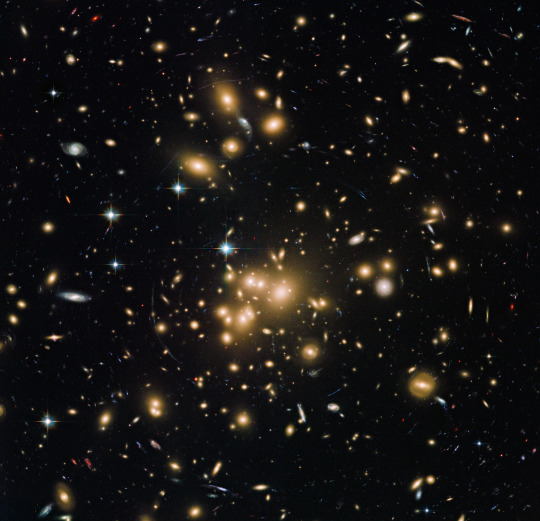
Abel 1689 is a one of the largest galaxy clusters in the known universe. It's located about 2.459 billion light-years away in constellation Virgo. Not only is this image visually beautiful, but the sheer number of gravitationally lensed galaxies across the entire image is just mind-blowing.
In 2008, one of the lensed galaxies, A1689-zD1, became known as the most distant galaxy from Earth based on a photometric redshift. 2008 also happens to be the same year the astronomy bug really bit me and it became one of my life-long passions.
You can find the original image file here.
PSZ1 G311.65-18.48 – Apus
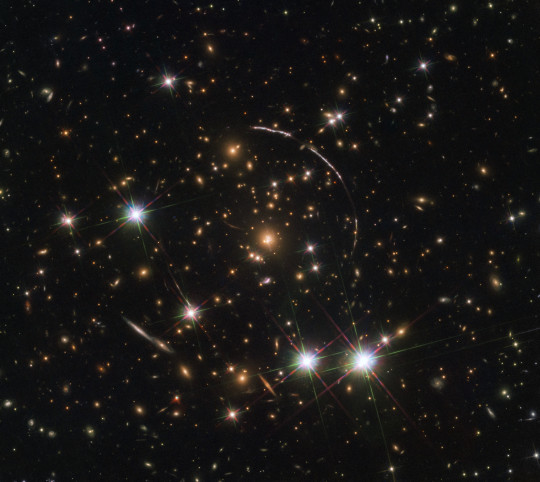
PSZ1 G311.65-18.48 is a massive galaxy cluster located 4.6 billion light-years away in the constellation Apus. What's especially remarkable about this image is that it features a bright galaxy that's been lensed 12 separate times along four arcs. Three of these arcs are visible to the upper right of the cluster, while a fainter fourth arc is partially obscured by a bright foreground star to the bottom left of the cluster. This galaxy is almost 12 billion light-years away from Earth, which given its title as the brightest gravitationally lensed galaxy is quite a remarkable feat.
You can find the original image file here.
MACS J0416.1-2403 – Eridanus

MACS J0416.1-2403 is another massive galaxy cluster located about 4 billion light years away in the constellation. Just…look at all those arcs. Across the entire image you can find countless lensed galaxies. The galaxy cluster itself has an interesting structure, appearing elongated along an arc through the centre of the image frame.
This galaxy cluster happened to have lensed a galaxy that existed about 400 million years after the Big Bang, or about 13.8 billion years ago. At the time of publication, this galaxy was the earliest, most distant object to have ever been observed. It was given the name Tayna, which means "first-born" in the Aymara language indigenous to Chile and Argentina.
You can read more about this cluster and find the original image file here.
MACS J1149+2223 – Leo
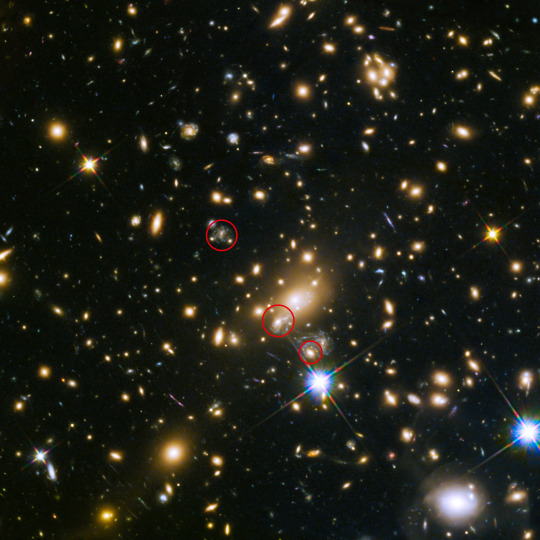
This image is a great example of how gravitational lensing obscures and reveals distant objects depending on our exact position and timing. The lowermost circle shows MACS J1149+2223, a galaxy cluster in the constellation Leo that lensed the Refsdal Supernova to produce four images. This is how the supernova was discovered on 11 November 2014.
The middle circle shows the predicted position of the reappearing supernova in late 2015 or early 2016. It reappeared as expected on 11 December 2015 and was imaged by Hubble.
The uppermost circle shows the position of the supernova as it could have been seen in 1995, but was not actually observed. The supernova may have also appeared elsewhere in the image about 40 to 50 years prior, between 1964 and 1974. Imagine if we had the technology and foresight to observe it then.
You can find the original image here.
3 notes
·
View notes
Photo

Galaxy Cluster Abell 1689 Warps Space
Credits: N. Benitez, JHU, Hebrew Univ., STScI, UCO/Lick, ACSScience Team, ESA, NASA
7 notes
·
View notes
Photo




Weird star produced the fastest nova on record cientists using the Atacama Large Millimeter/submillimeter Array (ALMA)— an international observatory co-operated by the US National Science Foundation’s National Radio Astronomy Observatory (NRAO)—have observed a significant amount of cold, neutral gas in the outer regions of the young galaxy A1689-zD1, as well as outflows of hot gas coming from the galaxy’s center. These results may shed light on a critical stage of galactic evolution for early galaxies, where young galaxies begin the transformation to be increasingly like their later, more structured cousins. The observations were presented today in a press conference at the 240th meeting of the American Astronomical Society (AAS) in Pasadena, California, and will be published in an upcoming edition of The Astrophysical Journal (ApJ). A1689-zD1— a young, active, star-forming galaxy that is slightly less luminous and less massive than the Milky Way— is located roughly 13 billion light-years away from Earth in the Virgo constellation cluster. It was discovered hiding out behind the Abell 1689 galaxy cluster in 2007 and confirmed in 2015 thanks to gravitational lensing, which amplified the brightness of the young galaxy by more than 9x. Since then, scientists have continued to study the galaxy as a possible analog for the evolution of other “normal” galaxies. That label— normal— is an important distinction that has helped researchers divide A1689-zD1’s behaviors and characteristics into two buckets: typical and uncommon, with the uncommon characteristics mimicking those of later and more massive galaxies. “A1689-zD1 is located in the very early Universe— only 700 million years after the Big Bang. This is the era where galaxies were just beginning to form,” said Hollis Akins, an undergraduate student in astronomy at Grinnell College and the lead author of the research. “What we’re seeing in these new observations is evidence of processes that may contribute to the evolution of what we call normal galaxies as opposed to massive galaxies. More importantly, these processes are ones we did not previously believe applied to these normal galaxies.” One of these uncommon processes is the galaxy’s production and distribution of star-forming fuel, and potentially a lot of it. The team used ALMA’s highly-sensitive Band 6 receiver to home in on a halo of carbon gas that extends far beyond the center of the young galaxy. This could be evidence of ongoing star formation in the same region or the result of structural disruptions, such as mergers or outflows, in the earliest stages of the galaxy’s formation. According to Akins, this is unusual for early galaxies. “The carbon gas we observed in this galaxy is typically found in the same regions as neutral hydrogen gas, which is also where new stars tend to form. If that is the case with A1689-zD1, the galaxy is likely much larger than previously thought. It’s also possible that this halo is a remnant of previous galactic activity, like mergers that exerted complex gravitational forces on the galaxy leading to the ejection of a lot of neutral gas out to these large distances. In either case, the early evolution of this galaxy was likely active and dynamic, and we’re learning that this may be a common, although previously unobserved, theme in early galaxy formation.” More than just uncommon, the discovery could have significant implications for the study of galactic evolution, particularly as radio observations uncover details unseen at optical wavelengths. Seiji Fujimoto, a postdoctoral researcher at the Niels Bohr Institute’s Cosmic Dawn Center, and a co-author of the research said, “The emission from the carbon gas in A1689-zD1 is much more extended than what was observed with Hubble Space Telescope, and this could mean that early galaxies are not as small as they appear. If, in fact, early galaxies are larger than we previously believed this would have a major impact on the theory of galaxy formation and evolution in the early Universe.” Led by Akins, the team also observed outflows of hot, ionized gas— commonly caused by violent galactic activity like supernovae— pushing outward from the center of the galaxy. It’s possible, given their potentially explosive nature, that the outflows have something to do with the carbon halo. “Outflows occur as a result of violent activity, such as the explosion of supernovae— which blast nearby gaseous material out of the galaxy— or black holes in the centers of galaxies— which have strong magnetic effects that can eject material in powerful jets. Because of this, there’s a strong possibility that the hot outflows have something to do with the presence of the cold carbon halo,” said Akins. “And that further highlights the importance of the multiphase, or hot to cold, nature of the outflowing gas.” Darach Watson, an associate professor at the Niels Bohr Institute’s Cosmic Dawn Center, and co-author of the new research confirmed A1689-zD1 as a high-redshift galaxy in 2015, making it the most distant dusty galaxy known. “We have seen this type of extended gas halo emission from galaxies that formed later in the Universe, but seeing it in such an early galaxy means that this type of behavior is universal even in the more modest galaxies that formed most of the stars in the early Universe. Understanding how these processes occurred in such a young galaxy is critical to understanding how star-formation happens in the early Universe.” Kirsten Knudsen, a professor of astrophysics in the Department of Space, Earth, and Environment at Chalmers University of Technology, and co-author of the research found evidence of A1689-zD1’s dust continuum in 2017. Knudsen pointed out the serendipitous role of extreme gravitational lensing in making each new discovery in the research possible. “Because A1689-zD1 is magnified more than nine times, we can see critical details that are otherwise difficult to observe in ordinary observations of such distant galaxies. Ultimately, what we’re seeing here is that early Universe galaxies are very complex, and this galaxy will continue to present new research challenges and results for some time.” Dr. Joe Pesce, NSF program officer for ALMA, added, "This fascinating ALMA research adds to a growing body of results indicating that things aren't quite as we expected in the early Universe, but they are really interesting and exciting nonetheless!" Spectroscopy and infrared observations of A1689-zD1 are planned for January 2023, using the NIRSpec Integral Field Unit (IFU) and NIRCam on the James Webb Space Telescope. The new observations will complement previous HST and ALMA data, offering a deeper and more complete multi-wavelength look at the young galaxy. TOP IMAGE....This artist’s conception illustrates the previously unknown complexity of the young galaxy, A1689-zD1. Reaching far beyond the center of the galaxy, shown here in pink, is an abundant halo of cold carbon gas. For scientists, this uncommon feature indicates that the galaxy may be much larger than previously believed and that early stages of normal galaxy formation may have been more active and dynamic than theorized. To the upper left and lower right are outflows of hot, ionized gas pushing outward from the center of the galaxy, shown here in red. Scientists believe it is possible that these outflows have something, though they don’t yet know what, to do with the presence of cold carbon gas in the outer reaches of the galaxy. CREDIT ALMA (ESO/NAOJ/NRAO), B. Saxton (NRAO/AUI/NSF) CENTRE IMAGE....A1689-zD1 is a star-forming galaxy located in the Virgo constellation cluster. It was first observed thanks to gravitational lensing from the Abell 1689 galaxy, which made the young galaxy appear nine times more luminous. New observations made using the Atacama Large Millimeter/submillimeter Array (ALMA) are revealing to scientists that the young galaxy, and others like it, may be bigger and more complex than originally thought. CREDIT ALMA (ESO/NAOJ/NRAO)/H.Akins (Grinnell College), B.Saxton (NRAO/AUI/NSF) LOWER IMAGE....This composite combines radio images of A1689-zD1, captured using the Atacama Large Millimeter/submillimeter Array (ALMA), shown in orange/red, with optical images from the Hubble Space Telescope (HST), shown in blue/white. In the context of its surroundings, it becomes clear how A1689-zD1 managed to “hide out” behind Abell 1689, and why gravitational lensing— the magnification of the young galaxy— are critical to studying its behaviors and processes. CREDIT ALMA (ESO/NAOJ/NRAO)/ H. Akins (Grinnell College), B.Saxton (NRAO/AUI/NSF) BOTTOM IMAGE....A1689-zD1 is a young, star-forming galaxy located in the Virgo constellation cluster, roughly 13 billion light-years away from Earth. CREDIT IAU/Sky & Telescope
5 notes
·
View notes
Link
0 notes
Text
Un nuovo modello per la materia oscura
Questa immagine del telescopio spaziale Hubble della NASA mostra la distribuzione della materia oscura al centro dell’ammasso di galassie giganti Abell 1689, contenente circa 1.000 galassie e trilioni di stelle. La materia oscura è una forma invisibile di materia che rappresenta la maggior parte della massa dell’universo. Hubble non può vedere direttamente la materia oscura. Gli astronomi hanno…

View On WordPress
0 notes
Text
MayBee - A Letter From Abell 1689
MayBee – A Letter From Abell 1689
메이비(MayBee) – A Letter From Abell 1689
Released: 2006.04.06
Genre: Ballad
TRACK LIST:
02. Miyeol (미열)
03. Som (숨)
04. Daso (다소)
05. Naesarang Mudeomkkaji (내사랑 무덤까지)
06. I Wish…
07. Candy
09. Eoje (어제)
11. Neutjam (늦잠)
12. Love²
13. Haebaragi (해바라기)
14. A Letter From Abell1689
MP3 320Kbps
.

View On WordPress
0 notes
Text

Cluster's Detail
63 notes
·
View notes
Photo

Galaxy Cluster Abell 1689 by NASA Goddard Photo and Video
289 notes
·
View notes
Photo
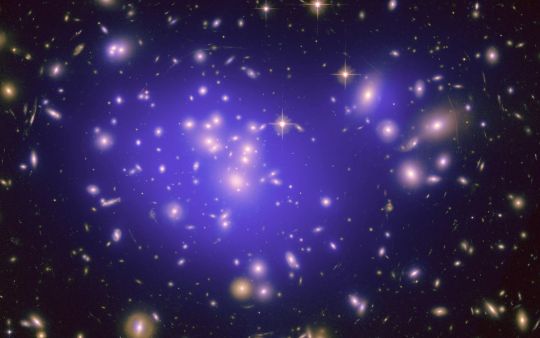
Abell 1689 - Cluster of Galaxies
#Abell 1689#Cluster of Galaxies#nasa#stargazing#astrophoto#astrophotography#galaxy#astronomy#universe#space#nebula#spinningblueball#thespinningblueball#milky way#milky way galaxy#milkywaygalaxy#spacephotography#nightsky#starrynight#milkywayphotography#astrophotos#starscape#star#cosmos#telescope#hubble#chandra#spitzer#hubble telescope#chandra telescope
73 notes
·
View notes
Photo

Dark matter map in galaxy cluster Abell 1689.
Credit: NASA, ESA, E Jullo, P Natarajan and J P Kneib
#Space#Astronomy#Astrophotography#Dark Matter#Abell 1689#NASA#ESA#E Jullo#P Natarajan#J P Kneib#Stars#Universe#Cosmos#Night sky#Galaxy#Constellation#Solar System#Deep Space#Science#Wonders#Photography#Nebula#Colors#Glow#Sparkle#Light
2K notes
·
View notes
Text
Apparently, NASA has a thing where you can enter your birthday and see what picture the Hubble Space Telescope took on your birthday. I decided to enter NCT 127’s birthdays, so here is...
“What Did Hubble See on Your Birthday?” (NCT 127 Edition)
Taeil:

On June 14 in 2002
Galaxy Cluster Abell 1689
This image shows the inner region of Abell 1689, an immense cluster of galaxies located 2.2 billion light-years away. Astronomers used Hubble to map the distrubition of dark matter in the galaxy cluster.
Johnny:

On February 9 in 2014
Monkey Head Nebula
This image reveals carved knots of gas and dust in a small portion of the Monkey Head Nebula. The nebula is a star-forming region that hosts dusky dust clouds silhouetted against glowing gas.
Taeyong:

On July 1 in 1993
Comet Shoemaker-Levy 9 Fragments
This image captures the brightest "nucleus" in a string of approximately 20 that comprised the broken-up comet Shoemaker-Levy 9. The image reveals that the bright segment is actually a group of at least four separate pieces.
Yuta:

On October 26 in 2009
Star Clusters in the Tarantula Nebula
The Tarantula Nebula is an enormous star-forming region located 170,000 light-years from Earth. The collection of stars in the core of the nebula, shown here, is made up of two individual star clusters that differ in age by about a million years.
Doyoung:

On February 1 in 2010
Carina Nebula Pillars
These cosmic pinnacles lie within a tempestuous stellar nursery called the Carina Nebula. Infant stars buried inside the pillars fire off jets of gas that stream away from the towering peaks.
Jaehyun:

On February 14 in 2007
Colliding Galaxies Arp 272
Arp 272 is a collision between two spiral galaxies, linked by their swirling arms. The galaxies are members of the Hercules Galaxy cluster and are located roughly 450 million light-years from Earth.
(I’m gonna post Winwin’s with WayV later)
Jungwoo:

On February 19 in 2014
Monkey Head Nebula (same as Johnny I guess..)
This image reveals carved knots of gas and dust in a small portion of the Monkey Head Nebula. The nebula is a star-forming region that hosts dusky dust clouds silhouetted against glowing gas.
Mark:

On August 2 in 1997
Hubble-V Nebula
Hubble-V is an active star-forming region within galaxy NGC 6822. The cloud is about 200 light-years across and contains a dense knot of dozens of ultra-hot stars, each 100,000 times brighter than our Sun.
Haechan:

On June 6 in 2003
Galaxy I Zwicky 18
This image captures the irregular dwarf galaxy I Zwicky 18 and a companion galaxy to its upper right. The two galaxies are interacting, triggering star formation in I Zwicky 18.
#nct#nct 127#nasa#taeil#johnny suh#taeyong#yuta#doyoung#jaehyun#jungwoo#mark lee#haechan#science#the hubble
28 notes
·
View notes
Photo
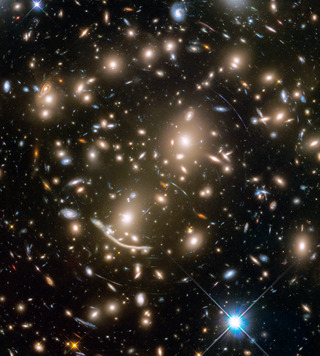


TOP IMAGE....Abell 370 is a cluster with several hundred galaxies at its core. It was one of the first clusters where astronomers observed gravitational lensing and part of the Frontier Fields project. Credits: NASA, ESA, R. Bouwens and G. Illingworth (University of California, Santa Cruz) CENTRE IMAGE....V838 Monoceroti became the brightest star in the entire Milky Way Galaxy in January 2002. Then, just as suddenly, it faded. Image Credit: NASA, ESA LOWER IMAGE....Hubble peered straight through the center of Abell 1689, one of the most massive galaxy clusters known. Credits: NASA, N. Benitez, T. Broadhurst, H. Ford, M. Clampin, G. Hartig, G. Illingworth, the ACS Science Team, and ESA
11 notes
·
View notes
Text
Astronomers Uncover One of the Youngest and Brightest Galaxies in the Early Universe
Astronomers Uncover One of the Youngest and Brightest Galaxies in the Early Universe
This image was taken in 2008 by NASA/ESA/JPL-Caltech/STScI. It still blows our mind.
A massive cluster of yellowish galaxies is seemingly caught in a spider web of eerily distorted background galaxies in the left-hand image, taken with the Advanced Camera for Surveys ACS aboard NASA Hubble Space Telescope.
By NASA
A massive cluster of yellowish galaxies is seemingly caught in a spider web of…
View On WordPress
0 notes